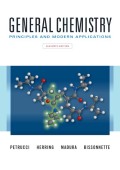
Concept explainers
(a)
Interpretation:
Write the appropriate name for
Concept introduction:
All know compounds are mainly classify as ionic and covalent compounds. In the naming of ionic compounds, the name of cation always comes first then the name of anion will come. Here cation is positively charged ion whereas anion is negatively charged ions. In the naming of covalent compounds, the name of center atom will come first followed by other atoms with certain suffix that depends on the charge and atoms. In the naming of polyatomic ions usually -ate suffix is used for those ions which have three or four O atoms.
(b)
Interpretation:
Write the appropriate name for
Concept introduction:
All know compounds are mainly classify as ionic and covalent compounds. In the naming of ionic compounds, the name of cation always comes first then the name of anion will come. Here cation is positively charged ion whereas anion is negatively charged ions. In the naming of covalent compounds, the name of center atom will come first followed by other atoms with certain suffix that depends on the charge and atoms. In the naming of polyatomic ions usually -ate suffix is used for those ions which have three or four O atoms.
(c)
Interpretation:
Write the appropriate name for
Concept introduction:
All know compounds are mainly classified as ionic and covalent compounds. In the naming of ionic compounds, the name of cation always comes first then the name of anion will come. Here cation is positively charged ion whereas anion is negatively charged ions. In the naming of covalent compounds, the name of center atom will come first followed by other atoms with certain suffix that depends on the charge and atoms. In the naming of polyatomic ions usually -ate suffix is used for those ions which have three or four O atoms.
Want to see the full answer?
Check out a sample textbook solution
Chapter 22 Solutions
EBK GENERAL CHEMISTRY
- A sample of an organic compound (a nonelectrolyte) weighing 1.35 g lowered the freezing point of 10.0 of benzene by 3.66 C. Calculate the molar mass of the compound.arrow_forwardWhat is the difference between sulfuric acid and hydrosulfuric acid?arrow_forward2. Write the symbol for each element • aluminium sulfate · kidney stones • component of teeth and bones · a hypochlorite in bleaches • strontium phosphide • potassium iodide · element; green gas • sodium cyanide •hypo in photography •nickel(II) chloride • potassium hydride • water, structural formula sodium phosphatearrow_forward
- Equivalent weight of Al(OH); is O 39 62 O 78 O 26arrow_forwardEx press te compas 1 tion f as percentage of its po elements. Q. Formald@hyde, CH20 b. Gucase, CeHi2 Of C. Acetic acid, HC2 H3 Oz te follousiny compoun-dsarrow_forward||| A ALEKS-Katelyn Pearson... 1 Apromatincat Rom Fecr] ATOMS, IONS AND MOLECULES Predicting the formula of ionic compounds with common... Write the empirical formula for at least four ionic compounds that could be formed from the following ions: OH, Fe²+, 103, NH b Answered. The following X O Garrow_forward
- What is Compound 4? CH;CI / AICI, Cl2 / FeCla CH,MgBr 2 H20 3 4 OH OH OH OH O B O D O Aarrow_forwardGive the number of protons and electrons in a. An N2 molecule b. An N3- unit c. An N5+ unit d. An N5N5 saltarrow_forward(NH,)2SO3 Nitrogen Hydrogen Sulfur Oxygen 1 ionic compound of (NH4)2503 atoms of N atoms of S atoms of O atoms of H 2 lonic. compounds of (NHA)2S03 atoms of N atoms of H atoms of S atoms of O S ionic compounds of (NH2)>SO3 atoms of N. atoms of H atoms of S[ atoms of O 111arrow_forward
- Which one of the following is not a match? Group of answer choices A. HNO3(aq) and nitric acid B. XeF4 and xenon tetrafluoride C. Cr2O3 and chromium(III) oxide D. Zn(NO3)2 and zinc nitritearrow_forwardPHOSPHOROUS...METAL OR NONMETAL? Phosphorous is highly reactive and never found as a free element on Earth. It can be found as white phosphorous and red phosphorus. White phosphorous is the more common form and, as the name suggests, is a white, waxy substance. White phosphorous emits a glow when exposed to oxygen, which is where the name Phosphorous come from. In Greek, phosphorous means "light bearer". Phosphorous is essential for life, where it is found in DNA, RNA, and ATP as well as the phospholipids which make up our cell membranes. Phosphorous is used by plants and thus fertilizer is used to replace phosphorous in the soil. Since phosphorous is so reactive it is even added to Napalm but more commonly you can find phosphorous in matches, where it is bonded to sulfur, which makes the head of a match much safer. White phosphorous melts at 44.1°C and boils at 280°C. It combines readily with chlorine and other halogens. Since it is so reactive it is stored under water in chemical…arrow_forwardWrite the empirical formula for at least four lonic compounds that could be formed from the following ions: Fe³+, SO, NO₂, Pb** 0 ap.... X 00arrow_forward
 Chemistry by OpenStax (2015-05-04)ChemistryISBN:9781938168390Author:Klaus Theopold, Richard H Langley, Paul Flowers, William R. Robinson, Mark BlaserPublisher:OpenStax
Chemistry by OpenStax (2015-05-04)ChemistryISBN:9781938168390Author:Klaus Theopold, Richard H Langley, Paul Flowers, William R. Robinson, Mark BlaserPublisher:OpenStax Chemistry: The Molecular ScienceChemistryISBN:9781285199047Author:John W. Moore, Conrad L. StanitskiPublisher:Cengage Learning
Chemistry: The Molecular ScienceChemistryISBN:9781285199047Author:John W. Moore, Conrad L. StanitskiPublisher:Cengage Learning Chemistry: An Atoms First ApproachChemistryISBN:9781305079243Author:Steven S. Zumdahl, Susan A. ZumdahlPublisher:Cengage Learning
Chemistry: An Atoms First ApproachChemistryISBN:9781305079243Author:Steven S. Zumdahl, Susan A. ZumdahlPublisher:Cengage Learning
 ChemistryChemistryISBN:9781305957404Author:Steven S. Zumdahl, Susan A. Zumdahl, Donald J. DeCostePublisher:Cengage Learning
ChemistryChemistryISBN:9781305957404Author:Steven S. Zumdahl, Susan A. Zumdahl, Donald J. DeCostePublisher:Cengage Learning Chemistry: Principles and ReactionsChemistryISBN:9781305079373Author:William L. Masterton, Cecile N. HurleyPublisher:Cengage Learning
Chemistry: Principles and ReactionsChemistryISBN:9781305079373Author:William L. Masterton, Cecile N. HurleyPublisher:Cengage Learning





